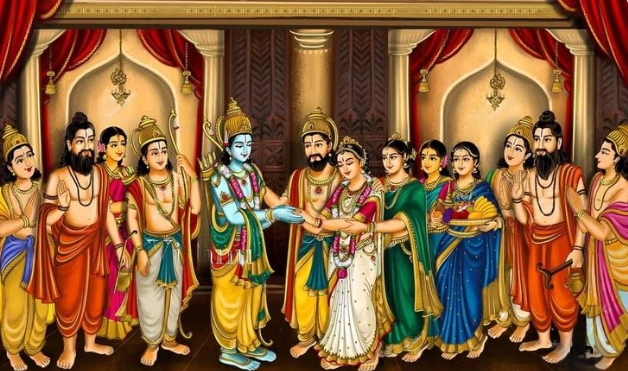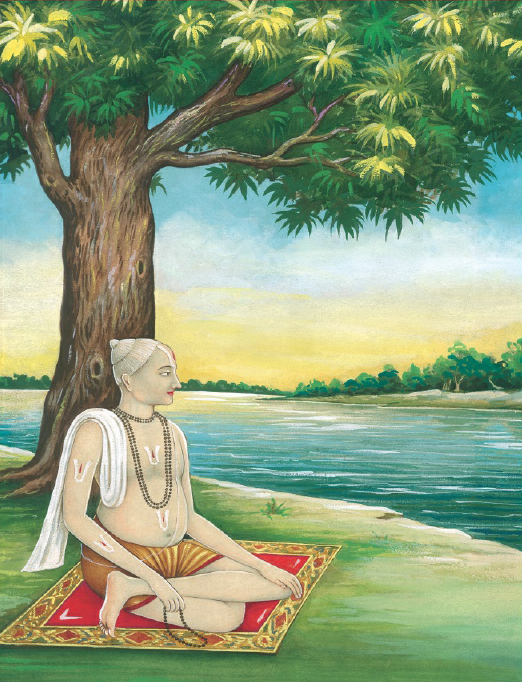Ayodhya Me Ram – Discover the Eternal Legacy of Lord Rama in Ayodhya

Tulsi Ramayana
Ramcharitmanas
Ramcharitmanas, also known as the Tulsi Ramayana, is an epic poem written by Goswami Tulsidas in the 16th century. It is a retelling of the ancient Indian epic, the Ramayana, in the Awadhi language. The Ramcharitmanas is revered as one of the greatest works of Hindu literature, and it holds a central place in the cultural and religious life of North India. The text is divided into seven chapters or Kaands, which narrate the story of Lord Rama's life, from his birth to his reign.
The text is divided into seven Kaands (chapters)
- 1. Baal Kaand
- 2. Ayodhya Kaand
- 3. Aranya Kaand
- 4. Kishkindha Kaand
- 5. Sundar Kaand
- 6. Lanka Kaand
- 7. Uttar Kaand
" होइहि सोइ जो राम रचि राखा। को करि तर्क बढ़ावै साखा॥
अस कहि लगे जपन हरिनामा। गईं सती जहँ प्रभु सुखधामा॥ "
भावार्थ:- जो कुछ राम ने रच रखा है, वही होगा। तर्क करके कौन शाखा (विस्तार) बढ़ावे। (मन में) ऐसा कहकर शिवजी भगवान् श्री हरि का नाम जपने लगे और सतीजी वहाँ गईं, जहाँ सुख के धाम प्रभु श्री रामचंद्रजी थे॥
Gist:- Whatever Ram has created will happen. Who will expand the branch by reasoning? Saying this (in mind), Lord Shiva started chanting the name of Lord Shri Hari and Satiji went to the place where Lord Shri Ramchandraji was the abode of happiness.
Chapter 1 (Childhood Episode)
Baal Kaand
This chapter describes the birth and childhood of Rama, his education, and his marriage to Sita. It also introduces other key characters like Rama's brothers, Lakshmana, Bharata, and Shatrughna.
Key Events
- Invocation and Introduction: Tulsidas begins with an invocation to various deities and introduces the purpose of writing the Ramcharitmanas.
- King Dasharatha’s Yajna: King Dasharatha of Ayodhya performs a yajna (sacrifice) to obtain sons. The gods bless him, and he is given a divine potion by Agni, the fire god.
- Birth of Rama and His Brothers: Rama is born to Queen Kausalya, Bharata to Queen Kaikeyi, and Lakshmana and Shatrughna to Queen Sumitra.
- Childhood Exploits: The young princes display extraordinary abilities and virtues.
- Sage Vishwamitra: Sage Vishwamitra comes to Ayodhya and requests Rama and Lakshmana to protect his yajna from demons. The brothers accompany him and perform heroic deeds.
- Swayamvara of Sita: Rama breaks the mighty bow of Shiva and wins the hand of Sita in her swayamvara (a ceremony for choosing a husband).


Chapter 2 (Ayodhya Episode)
Ayodhya Kaand
This chapter describes the events leading up to Rama's exile, including the intrigues of his stepmother, Queen Kaikeyi, and the departure of Rama, Sita, and Lakshmana from Ayodhya.
Key Events
- Preparations for Coronation: King Dasharatha decides to coronate Rama as the prince regent.
- Kaikeyi’s Boons: Queen Kaikeyi, influenced by her maid Manthara, demands the fulfillment of two boons previously granted by Dasharatha: the coronation of her son Bharata and Rama's exile for 14 years.
- Rama’s Exile: Rama, adhering to his father's promise, prepares to leave for the forest. Sita and Lakshmana insist on accompanying him.
- Dasharatha’s Demise: The grief-stricken king Dasharatha dies.
- Bharata’s Response: Bharata returns from his maternal uncle’s home, is devastated by the events, and refuses to be king. He goes to the forest to persuade Rama to return, but Rama refuses, honoring his father's promise. Bharata takes Rama’s sandals and places them on the throne, ruling Ayodhya as Rama’s representative.
Chapter 3 (Forest Episode)
Aranya Kaand
This chapter narrates the story of Rama's exile in the forest, including their encounters with various sages, demons, and animals. It also describes the abduction of Sita by Ravana.
Key Events
- Life in the Forest: Rama, Sita, and Lakshmana travel through various forests, meeting sages and encountering demons.
- Panchavati: They settle in Panchavati, where they build a hut and live peacefully.
- Shurpanakha’s Incident: Shurpanakha, Ravana’s sister, tries to seduce Rama and Lakshmana. Lakshmana cuts off her nose and ears, leading her to seek revenge.
- Abduction of Sita: Ravana, angered by Shurpanakha’s humiliation, abducts Sita and takes her to Lanka.
- Jatayu’s Sacrifice: The noble vulture Jatayu attempts to rescue Sita but is fatally wounded by Ravana.
- Meeting Hanuman: Rama and Lakshmana meet Hanuman, who leads them to Sugriva, the exiled monkey king.


Chapter 4 (Kishkindha Episode)
Kishkindha Kaand
This chapter tells the story of Rama's alliance with the monkey king, Sugriva, and his brother, Vali. It also describes the search for Sita and the battle between Rama and Vali.
Key Events
- Alliance with Sugriva: Rama forms an alliance with Sugriva, helping him reclaim his throne from his brother Vali.
- Search for Sita: Sugriva sends out search parties in all directions to find Sita.
- Hanuman’s Mission: Hanuman, being the mightiest and most devoted, is sent southward and eventually leaps across the ocean to Lanka.
Chapter 5 (Beautiful Episode)
Sundar Kaand
This chapter is considered the most beautiful and sacred part of the Ramcharitmanas. It describes Hanuman's journey to Lanka, his meeting with Sita, and his return to Rama with news of her whereabouts.
Key Events
- Hanuman’s Journey to Lanka: Hanuman overcomes various obstacles and reaches Lanka.
- Finding Sita: He finds Sita in the Ashoka grove, consoles her, and gives her Rama’s ring as a token.
- Hanuman’s Feats: Hanuman’s strength and devotion are showcased as he defeats many demons, sets Lanka on fire, and returns to Rama with news of Sita’s whereabouts.
Play Sundarkaand


Chapter 6 (Yuddh Kaand)
Lanka Kaand
This chapter describes the war between Rama's forces and Ravana's army, including the famous duel between Rama and Ravana.
Key Events
- Preparation for War: Rama and his allies, including the monkey army, build a bridge to Lanka (Rama Setu) and cross over.
- The Great Battle: A fierce battle ensues between Rama’s army and Ravana’s forces. Key battles include those with Ravana’s brothers, Kumbhakarna and Vibhishana, who defects to Rama’s side.
- Ravana’s Defeat: Rama confronts and kills Ravana, rescuing Sita.
- Agni Pariksha: To prove her purity, Sita undergoes a trial by fire (Agni Pariksha) and emerges unscathed.
Chapter 7 (Epilogue)
Uttar Kaand
This final chapter describes Rama's return to Ayodhya, his coronation, and his reign. It also includes the story of Sita's banishment and her eventual reunion with Rama.
Key Events
- Return to Ayodhya: Rama, Sita, and Lakshmana return to Ayodhya, where Rama is crowned king.
- Rama Rajya: Rama’s reign is described as an era of peace and prosperity.
- Sita’s Exile: Sita is sent into exile due to societal rumors about her chastity. She takes refuge in Sage Valmiki’s ashram, where she gives birth to Rama’s twin sons, Lava and Kusha.
- Lava and Kusha: The twins grow up learning the story of Rama from Valmiki and eventually reunite with their father.
- Sita’s Return to the Earth: Sita, proving her purity once more, returns to the earth, from where she was born.
- Rama’s Departure: The epic concludes with Rama’s departure from the world, returning to his divine abode.

"The Ramcharitmanas by Tulsidas is more than just a retelling of the Ramayana. It is a spiritual, moral, and cultural treasure that continues to guide and inspire people. Its themes of righteousness, devotion, and the eternal battle between good and evil resonate deeply with human values. Through the Ramcharitmanas, Tulsidas has immortalized the story of Lord Rama, making it accessible and relevant for all times."
Goswami Tulsidas Ji
Goswami Tulsidas Ji is one of the most revered and influential poet-saints in Indian history. Known for his devotion to Lord Rama, Tulsidas is best remembered for composing the Ramcharitmanas, an epic retelling of the Ramayana in the Awadhi language. His works have had a profound impact on the cultural, religious, and literary landscape of India.
Goswami Tulsidas Ji’s life and works have left an indelible mark on the spiritual and cultural fabric of India. Through his poetic genius and deep devotion, he brought the divine story of Lord Rama closer to the hearts of the common people, fostering a profound sense of devotion and moral integrity. His legacy continues to inspire and guide countless individuals on the path of righteousness and devotion.

